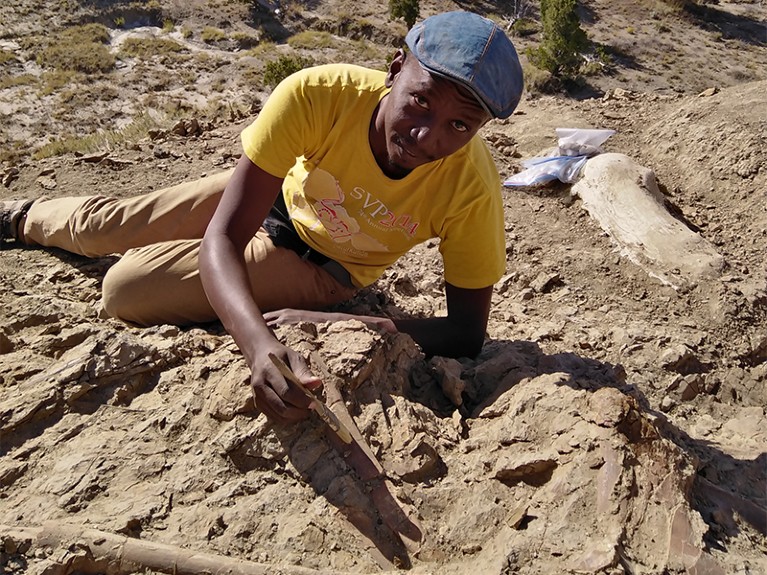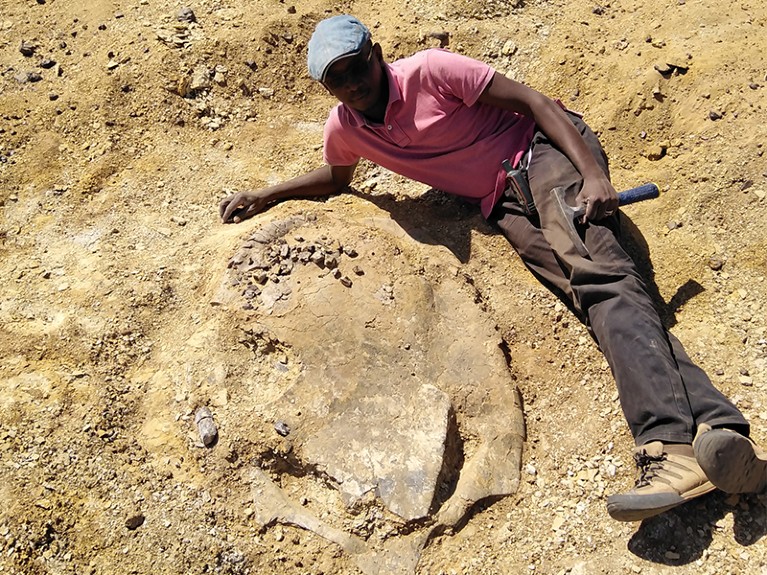
Khalafallah Salih in training to excavate a Hadrosaurus dinosaur fossil in 2019 at the Grand Staircase-Escalante National Monument in Utah.Credit: Doug Shore
As an undergraduate studying geology at Al Neelain University in Khartoum in the early 2000s, Khalafallah Salih assumed he would pursue a career in petroleum exploration, like nearly all his peers. Instead, he was captivated by the dinosaur and giant-crocodile fossils found in geological deposits, shifting his career path permanently. Even though neither Sudanese universities nor government agencies offered studies in vertebrate palaeontology, Salih began building partnerships and communicating with veteran palaeontologists abroad after he graduated in 2006. These relationships eventually helped Salih to earn a PhD in vertebrate palaeontology from the Technical University of Berlin and the Natural History Museum Berlin (MfN Berlin) in 2018, making him one of the first Sudanese researchers to do so.
Despite a lack of national funding for palaeontology research and the political unrest in Sudan, he returned home to investigate fossils in the east and north of the country. Now, alongside his fieldwork, Salih has set up the first vertebrate palaeontology courses for undergraduate students at Al Neelain.
How did you break into vertebrate palaeontology?
After graduation, my family expected me to have a highly regarded oil-company job, one of the most prestigious and high-paying professions in my country. But, I had already fallen in love with palaeontology, which was not possible to study in Sudan or even abroad by obtaining a government scholarship. Therefore, I started contacting more than 30 palaeontological researchers and centres around the world through e-mail. I presented research plans, shared ideas and asked for advice. In 2010, Johannes Müller, a palaeontologist at MfN Berlin, offered me a spot on a palaeontological project to investigate vertebrate diversity of Late Cretaceous sites [100 million to 66 million years ago] in northern Sudan. At the same time, I could complete my master’s in Berlin with funding from the project.
What motivated you to return to Sudan?
The outbreak of pro-democracy protests in Sudan in 2018 encouraged me to return home as soon as I finished my PhD, so that I could help to make positive changes in my country through my work. In Sudan, there was no national research activity in this field before I joined it. Hence, my goal is to form a local team of vertebrate palaeontologists. Building this type of capacity in Sudan would lead to the dissemination of palaeontology science among the population.
Which species do you focus on?
My fieldwork mainly focuses on crocodilian, dinosaur and hominin fossils. Through an international collaborative project in north Sudan between 2011 and 2014, we discovered Brachiosuchus kababishensis, a species in the Dyrosauridae family that lived from Late Cretaceous to the Eocene epoch [72 million to 33 million years ago]. This long-snouted crocodyliform had a unique characteristic: its forelimbs, which are longer than its hindlimbs, made it a highly manoeuvrable underwater predator. It is also one of the few vertebrates to have survived the mass extinction event of that time.

Khalafallah Salih unearths the fossil of a Late Cretaceous turtle in the Shendi formation in Sudan in 2021.Credit: Mosab Malik
I also help to train employees of the Geological Research Authority of the Sudan, to examine and classify fossils they uncover in their work. Meanwhile, I work with colleagues from Germany, the United States, Japan and France in the PALEONILE project to reveal new fossils of Pleistocene mammals, including hominins, in Sudan. We aim to reveal the role of the Nile River in promoting hominin evolution and dispersal between the Rift Valley in Ethiopia and North Africa, and beyond to Eurasia. We started fieldwork for this in January.
Being involved in this research made me feel that Sudan no longer stands by as a spectator when unveiling its natural history. Future local researchers should take the lead — not just wait for research teams to come from abroad.
Tell us about the core group of junior palaeontologists you are building.
I started teaching the first vertebrate palaeontology courses in Sudan at Al Neelain in 2020. Four fourth-year undergraduate students formed an outdoor training group under my leadership for their graduation project. The project is about the vertebrate fossils of the Shendi formation near Khartoum; its rocky layers of Cretaceous deposits contain a treasure trove of fossilized remains. Now, although their degrees are in petroleum geology, they are about to graduate with expertise in vertebrate fossils.
Having more local palaeontologists helps to attract media and government attention to Sudan’s palaeontological sites. This improves public awareness of palaeontology — many people think we are digging for gold or stealing antiquities and lying about our work.
Why would the Sudanese public be sceptical about your work?
The conservative mainstream population often collides with and rejects the value of certain scientific fields. I also face underestimation by some other academics, who say that I’m wasting my time on meaningless bones. Also, many citizens have never heard about palaeontological digs before.
Local misunderstandings have been exacerbated by Sudan’s gold rush, which began about 11 years ago — community suspicions that we are searching for gold make it difficult for us to move around and dig. There are large amounts of gold deposits to the northeast of Khartoum, where we do most of our outdoor work. Traditional miners and illegal prospectors dig for glimmers of gold, collect rocks and transport them in searing heat — looking very much like we do in our work. Furthermore, the region belonged to the Nubian and Kushite ancient Kingdoms that dominated Sudan from 3100 to 350 bc, and we work not far from more than 200 pyramids of royal tombs that were once filled with treasures.
Political turbulence also brings difficulties. Since 2019, my position at Al Neelain has changed drastically in tandem with a series of changes in government. It is an increasingly divisive landscape in which politics has become deeply rooted in academic life. It’s really a big challenge to keep going with research with the possibility of being excluded at any time because of your political beliefs. Therefore, I stand apart from political arguments as much as possible.
How do you work amid such turmoil?
I usually resort to discussion, using photos and videos to explain the importance of what we do and to combat misinformation. I share my research papers with local leaders who can help me get government permits for excavating and shipping fossils. For the local people to allow us to dig, we are keen to enlighten them about our work and we have long conversations with them before we start working. We also employ some of them to work with us on excavating sites, so that they can be confident that our work is honest.

 The ancient whale from my Egyptian home town
The ancient whale from my Egyptian home town
 Treading carefully: saving frankincense trees in Yemen
Treading carefully: saving frankincense trees in Yemen
 How three Ukrainian scientists are surviving Russia’s brutal war
How three Ukrainian scientists are surviving Russia’s brutal war
 Capacity building to boost science in Ethiopia
Capacity building to boost science in Ethiopia








